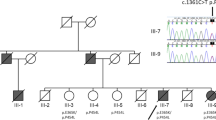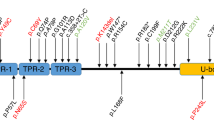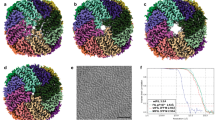Abstract
We describe here a previously unknown, dominantly inherited, late-onset basal ganglia disease, variably presenting with extrapyramidal features similar to those of Huntington's disease (HD) or parkinsonism. We mapped the disorder, by linkage analysis, to 19q13.3, which contains the gene for ferritin light polypeptide (FTL). We found an adenine insertion at position 460–461 that is predicted to alter carboxy-terminal residues of the gene product. Brain histochemistry disclosed abnormal aggregates of ferritin and iron. Low serum ferritin levels also characterized patients. Ferritin, the main iron storage protein, is composed of 24 subunits of two types (heavy, H and light, L) which form a soluble, hollow sphere1. Brain iron deposition increases normally with age, especially in the basal ganglia, and is a suspected causative factor in several neurodegenerative diseases2 in which it correlates with visible pathology3, possibly by its involvement in toxic free-radical reactions4. We found the same mutation in five apparently unrelated subjects with similar extrapyramidal symptoms. An abnormality in ferritin strongly indicates a primary function for iron in the pathogenesis of this new disease, for which we propose the name 'neuroferritinopathy'.
This is a preview of subscription content, access via your institution
Access options
Subscribe to this journal
Receive 12 print issues and online access
$209.00 per year
only $17.42 per issue
Buy this article
- Purchase on Springer Link
- Instant access to full article PDF
Prices may be subject to local taxes which are calculated during checkout





Similar content being viewed by others
References
Harrison, P.M. & Arosio, P. The ferritins: molecular properties, iron storage function and cellular regulation. Biochim. Biophys. Acta 1275, 161–203 (1996).
Gerlach, M., Ben-Shachar, D., Riederer, P. & Youdim, M.B. Altered brain metabolism of iron as a cause of neurodegenerative diseases? J. Neurochem. 63, 793–807 (1994).
Dexter, D.T., Jenner, P., Schapira, A.H. & Marsden, C.D. Alterations in levels of iron, ferritin, and other trace metals in neurodegenerative diseases affecting the basal ganglia. The Royal Kings and Queens Parkinson's Disease Research Group. Ann. Neurol. 32, S94–100 (1992).
Nappi, A.J. & Vass, E. Iron, metalloenzymes and cytotoxic reactions. Cell Mol. Biol. (Noisy-Le-Grand) 46, 637–647 (2000).
Ashworth, L.K. et al. An integrated metric physical map of human chromosome 19. Nature Genet. 11, 422–427 (1995).
Reguigne-Arnould, I. et al. Relative positions of two clusters of human alpha-L-fucosyltransferases in 19q (FUT1-FUT2) and 19p (FUT6-FUT3-FUT5) within the microsatellite genetic map of chromosome 19. Cytogenet. Cell Genet. 71, 158–162 (1995).
Hempstead, P.D. et al. Comparison of the three-dimensional structures of recombinant human H and horse L ferritins at high resolution. J. Mol. Biol. 268, 424–448 (1997).
Santoro, C. et al. Cloning of the gene coding for human L apoferritin. Nucleic Acids Res. 14, 2863–2876 (1986).
McGill, J.R. et al. Human ferritin H and L sequences lie on ten different chromosomes. Hum. Genet. 76, 66–72 (1987).
Gatti, R.A., Shaked, R., Mohandas, T.K. & Salser, W. Human ferritin genes: chromosomal assignments and polymorphisms. Am. J. Hum. Genet. 41, 654–667 (1987).
Worwood, M. The diagnostic value of serum ferritin determinations for assessing iron status. Haematologia 20, 229–235 (1987).
Morris, C.M., Candy, J.M., Oakley, A.E., Bloxham, C.A. & Edwardson, J.A. Histochemical distribution of non-haem iron in the human brain. Acta Anat. 144, 235–257 (1992).
Taylor, T.D. et al. Homozygosity mapping of Hallervorden-Spatz syndrome to chromosome 20p12.3-p13. Nature Genet. 14, 479–481 (1996).
Sheth, S. & Brittenham, G.M. Genetic disorders affecting proteins of iron metabolism: clinical implications. Annu. Rev. Med. 51, 443–464 (2000).
Takahashi, Y. et al. Characterization of a nonsense mutation in the ceruloplasmin gene resulting in diabetes and neurodegenerative disease. Hum. Mol. Genet. 5, 81–84 (1996).
Juan, S.H. & Aust, S.D. Mutational analysis of loading of iron into rat liver ferritin by ceruloplasmin. Arch. Biochem. Biophys. 361, 295–301 (1999).
Cavadini, P., Gellera, C., Patel, P.I. & Isaya, G. Human frataxin maintains mitochondrial iron homeostasis in saccharomyces cerevisiae. Hum. Mol. Genet. 9, 2523–2530 (2000).
Hilditch-Maguire, P. et al. Huntingtin: an iron-regulated protein essential for normal nuclear and perinuclear organelles. Hum. Mol. Genet. 9, 2789–2797 (2000).
LaVaute, T. et al. Targeted deletion of the gene encoding iron regulatory protein-2 causes misregulation of iron metabolism and neurodegenerative disease in mice. Nature Genet. 27, 209–214 (2001).
Jappelli, R. & Cesareni, G. Cooperativity of mutational effects within a six amino acid residues substitution that induces a major conformational change in human H ferritin. Biochem. Biophys. Res. Commun. 250, 342–346 (1998).
Olanow, C.W. & Arendash, G.W. Metals and free radicals in neurodegeneration. Curr. Opin. Neurol. 7, 548–558 (1994).
Dib, C. et al. A comprehensive genetic map of the human genome based on 5,264 microsatellites. Nature 380, 152–154 (1996).
Lathrop, G.M., Lalouel, J.M., Julier, C. & Ott, J. Multilocus linkage analysis in humans: detection of linkage and estimation of recombination. Am. J. Hum. Genet. 37, 482–498 (1985).
Acknowledgements
We thank the family for their support over many years, K. Archibald of the Northern Genetics Service for doing disease-specific tests, the North Cumbria Community Genetics Project and Westlakes Research Institute for access to control DNA samples and the Cumbria County Records Office for genealogical research. The work is supported by the Borwick Trust and the Royal Victoria Infirmary Special Trustees. C.M.M. and A.P.J. are supported by the Medical Research Council. The paper is dedicated to the late D. Gibson, our genetic nurse, who devoted many hours to the care of this family and tracing of the pedigree.
Author information
Authors and Affiliations
Corresponding author
Rights and permissions
About this article
Cite this article
Curtis, A., Fey, C., Morris, C. et al. Mutation in the gene encoding ferritin light polypeptide causes dominant adult-onset basal ganglia disease. Nat Genet 28, 350–354 (2001). https://doi.org/10.1038/ng571
Received:
Accepted:
Published:
Issue Date:
DOI: https://doi.org/10.1038/ng571
This article is cited by
-
Iron imbalance in neurodegeneration
Molecular Psychiatry (2024)
-
Pathogenic mechanism and modeling of neuroferritinopathy
Cellular and Molecular Life Sciences (2021)
-
New Insights into the Role of Ferritin in Iron Homeostasis and Neurodegenerative Diseases
Molecular Neurobiology (2021)
-
Iron stored in ferritin is chemically reduced in the presence of aggregating Aβ(1-42)
Scientific Reports (2020)
-
Purinergic Receptors in Basal Ganglia Diseases: Shared Molecular Mechanisms between Huntington’s and Parkinson’s Disease
Neuroscience Bulletin (2020)



